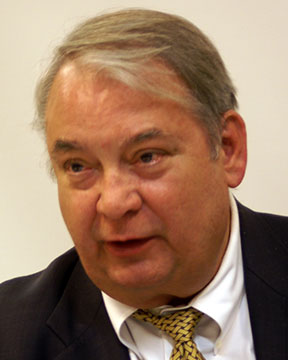ORALS
SESSION: AdvancedMaterialsWedAM-R6
| 4th Intl. Symp. on New and Advanced Materials and Technologies for Energy, Environment and Sustainable Development |
| Wed Nov, 7 2018 / Room: Guaratiba (60/2nd) | |
| Session Chairs: Patrick Ching-Ho Hsieh; Udo Schwingenschlogl; Session Monitor: TBA |
11:45: [AdvancedMaterialsWedAM02] Keynote
Ab-initio Calculations of the Thermoelectric Properties of MXenes Udo
Schwingenschlogl1 ;
1King Abdullah University of Science and Technology (KAUST), Thuwal, Saudi Arabia;
Paper Id: 285
[Abstract] This presentation gives an overview of ab-initio calculations [1-3] addressing the thermoelectric performance of MXenes. Specific examples include a comparison of Ti<sub>2</sub>CO<sub>2</sub>, Zr<sub>2</sub>CO<sub>2</sub>, and Hf<sub>2</sub>CO<sub>2</sub> in order to evaluate the role of the metal atom. The lattice thermal conductivity is demonstrated to grow along the series Ti-Zr-Hf in the temperature range 300-700 K, resulting in the highest figure of merit in the case of Ti<sub>2</sub>CO<sub>2</sub>. Flat conduction bands promote the thermopower in the case of n-doping. Functionalization effects are studied for Sc<sub>2</sub>C, which is semiconducting for various functional groups, including O, F, and OH. The lowest lattice thermal conductivity is found for OH functionalization. Therefore, despite a relatively low thermopower, Sc<sub>2</sub>C(OH)<sub>2</sub> may be interesting for intermediate-temperature thermoelectric applications due to a high electrical conductivity. We also discuss results on heterostructures built from MXenes and transition metal dichalcogenide monolayers. Low frequency optical phonons are found to occur as a consequence of the van der Waals bonding. They contribute significantly to thermal transport and compensate for reduced contributions of the acoustic phonons (strong scattering in heterostructures), such that the thermal conductivities become similar to those of the constituent MXenes.
References:
[1] A. N. Gandi, H. N. Alshareef, and U. Schwingenschlogl, Chem. Mater. 28 (2016), 1647-1652.
[2] S. Kumar and U. Schwingenschlogl, Phys. Rev. B 94 (2016), 035405.
[3] A. N. Gandi, H. N. Alshareef, and U. Schwingenschlogl, J. Phys.: Condens. Matter 29 (2017), 035504.
SESSION: CompositeMonPM1-R8
| 6th Intl. Symp. on Composite, Ceramic and Nano Materials Processing, Characterization and Applications |
| Mon Nov, 5 2018 / Room: Grego (50/3rd) | |
| Session Chairs: Raman Singh; Gabor Patonay; Session Monitor: TBA |
15:15: [CompositeMonPM108]
Thermoelectric Properties of the Layered Rhodates K<sub>x</sub>RhO<sub>2</sub> and Na<sub>x</sub>CoO<sub>2</sub> Udo
Schwingenschlogl1 ; Nirpendra
Singh
1 ; Yasir
Saeed
1 ;
1King Abdullah University of Science and Technology (KAUST), Thuwal, Saudi Arabia;
Paper Id: 290
[Abstract] We discuss the structural and thermoelectric properties of the layered compounds K<sub>x</sub>RhO<sub>2</sub> [1] in comparison to isostructural and isovalent Na<sub>x</sub>CoO<sub>2</sub>. The optimized structure of K<sub>1/2</sub>RhO<sub>2</sub> exhibits a remarkable deviation of the c/a ratio from the experimental result as well as from c/a ratios of related compounds. This indicates that a hydrated phase of K<sub>x</sub>RhO<sub>2</sub> exists and the experimental structure determination refers to this hydrated phase. The calculated Seebeck coefficient of pristine K<sub>1/2</sub>RhO<sub>2</sub> amounts to 50*10<sup>-6</sup> V/K at 300 K, which is close to the experimental value of 40*10<sup>-6</sup> V/K. More importantly, we observe high values for the Seebeck coefficient and power factor for hydrated K<sub>x</sub>RhO<sub>2</sub> in the whole temperature range from 0 to 700 K. At 100 K we find for hydrated K<sub>7/8</sub>RhO<sub>2</sub> a value of Z = 3*10<sup>-3</sup> K<sup>-1</sup>, which is the highest power factor observed at this temperature. It exceeds also the exceptionally high value of Na<sub>0.88</sub>CoO<sub>2</sub> by more than 50%. Our results, hence, demonstrate that hydration is an effective approach to modify the lattice parameters and, as a result, enhance the thermoelectric performance. The Na<sub>x</sub>RhO<sub>2</sub> oxides [2] are found to form a new class of materials with exciting thermoelectric features, even outperforming the 2H phases of the K<sub>x</sub>RhO<sub>2</sub> system. In the latter the optimal thermoelectric performance is achieved at low temperature, whereas the modified stacking of the atomic layers in the 3R phases of Na<sub>x</sub>RhO<sub>2</sub> results in a reduced interlayer coupling and, in turn, in a dramatically enhanced thermoelectric response in the technologically relevant high temperature range. We find that Na vacancies in Na<sub>x</sub>RhO<sub>2</sub> avoid clustering and that the RhO<sub>6</sub> octahedra are modified depending on the amount of Na deficiency. Analysis of the induced changes in the density of states close to the Fermi level indicates that the Rh<sup>3+d</sup> d<sub>3z2-r2</sub> states control the transport properties of the compounds. A substantial figure of merit of 0.35 at 580 K is found in hydrated Na<sub>0.83</sub>RhO<sub>2</sub> due to the enhanced effective mass of the charge carriers. In general, the figure of merit can be further increased by reduction of the Na vacancy concentration to increase the resistivity.
References:
[1] Y. Saeed, N. Singh, and U. Schwingenschlogl, Adv. Funct. Mater. 22 (2012), 2792-2796.
[2] Y. Saeed, N. Singh, and U. Schwingenschlogl, Sci. Rep. 4 (2014), 4390.
15:40 Break



















